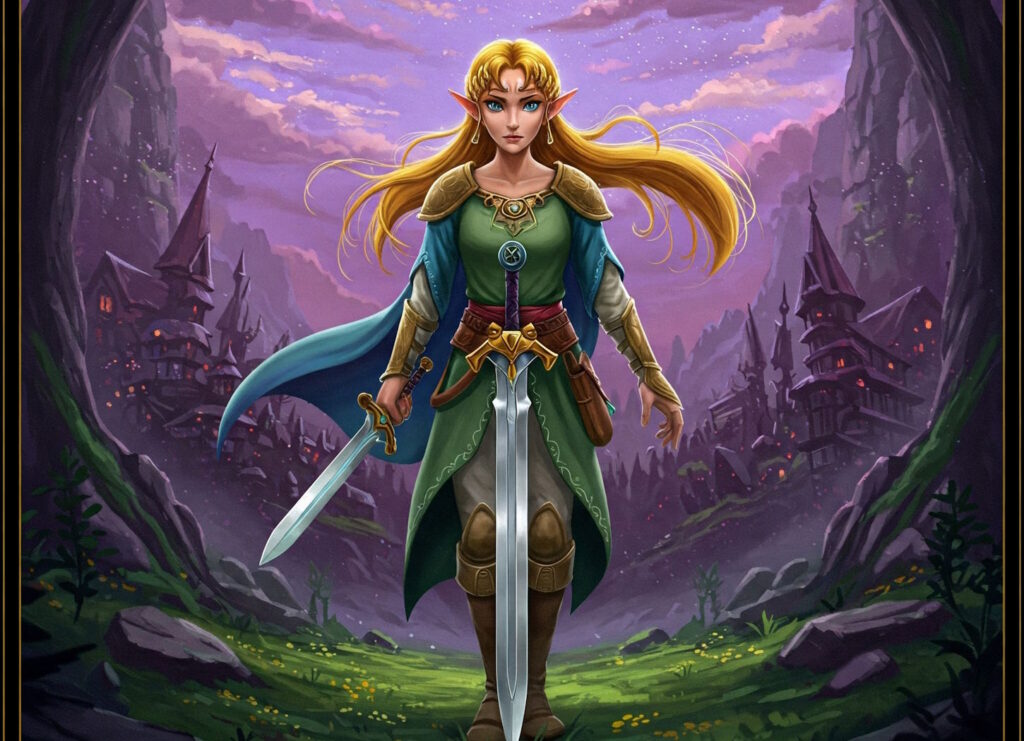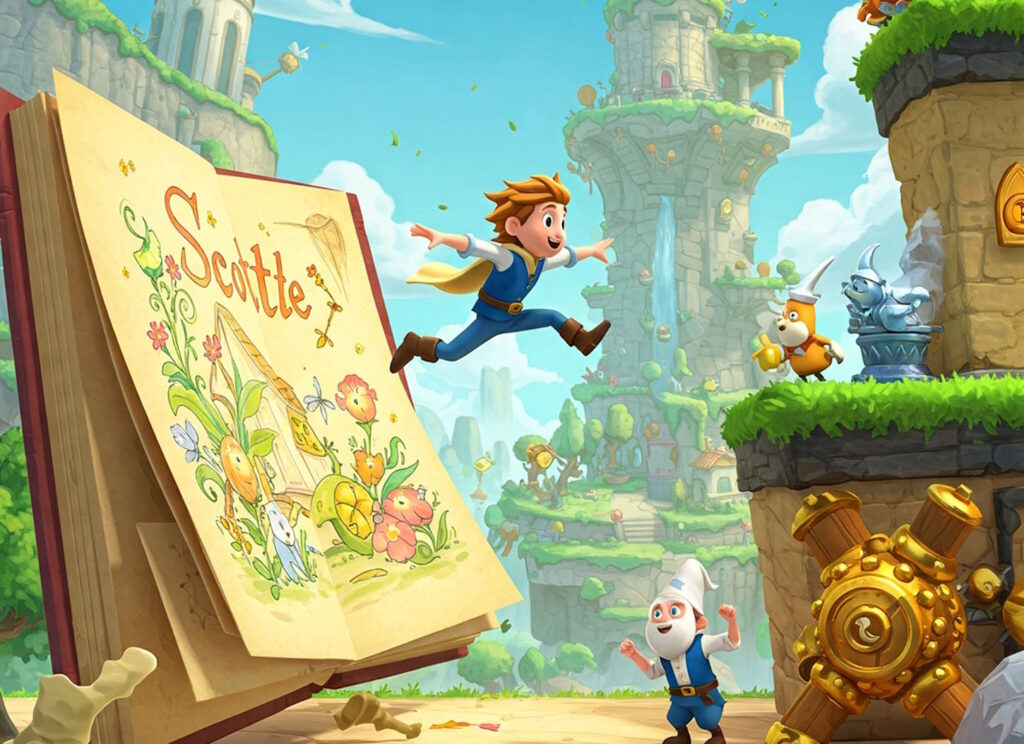Introduction to Arzette: The Jewel of Faramore
Arzette: The Jewel of Faramore stands as a heartfelt tribute to the classic Zelda series, rekindling the nostalgia and wonder that defined an era of gaming. This title encapsulates the charm of retro adventures through its meticulous design and engrossing gameplay, appealing to both dedicated fans of the genre and newcomers alike. In the game, players find themselves immersed in a vibrant world filled with magical landscapes and intricate quests, drawing heavily on the visual and narrative aesthetics of timeless gaming classics.
The premise revolves around the protagonist, a courageous hero tasked with saving the kingdom of Faramore from an ominous force. As players navigate through various challenges, they encounter a plethora of characters and creatures, all beautifully rendered in a pixel art style reminiscent of the original Zelda games. This visual homage, combined with engaging puzzle-solving elements, enhances the experience, facilitating a deep connection to the beloved legacy that has inspired Arzette.
Furthermore, the game is steeped in lore, elaborating on the mythical Jewel of Faramore, which holds the power to restore peace to the land. The crafting of its narrative, alongside its engaging gaming mechanics, reflects the essence of adventure and exploration found in the Zelda franchise. As a modern title, Arzette seeks not only to echo the beloved gameplay of yesteryears but also to innovate within the framework laid down by its predecessors.
What sets Arzette apart in the realm of retro-inspired games is its ability to honor the past while offering a fresh experience tailored for contemporary audiences. It serves as a reminder of the timeless allure of adventure gaming, prompting players to embark on a quest filled with discovery, courage, and enchantment. The unique combination of nostalgic elements and new ideas makes Arzette a noteworthy entry in the world of indie gaming and a delightful homage to classic Zelda.
The Storyline and Characters
Arzette: The Jewel of Faramore unfolds in a richly designed world, brimming with adventure, captivating characters, and epic challenges. The story centers around the protagonist, a young warrior tasked with the formidable responsibility of restoring peace to the kingdom of Faramore. At the outset, players are introduced to a vibrant yet troubled realm where darkness looms due to the actions of an enigmatic antagonist, the Shadow Monarch. His desire to control the ancient jewel of Faramore, a source of immense power, sets the stage for the protagonist’s quest.
As the narrative progresses, the protagonist embarks on a journey that takes them through enchanted forests, treacherous mountains, and mysterious ruins. Along this path, players meet a diverse cast of characters, each contributing significantly to the storyline. Allies, such as the wise sorceress Elara and the brave knight Thorne, play crucial roles in the protagonist’s growth and development. The interplay between these characters highlights themes of friendship, where bonds are forged through shared struggles, and courage, as they overcome obstacles together.
The Shadow Monarch’s motives unravel throughout the game, revealing a tragic backstory that adds depth to his character. Driven by a desire for power, he embodies the struggles between light and darkness, making him a compelling antagonist. Additionally, supporting characters, like the clever rogue Kael and the nurturing healer Liora, help to weave a tapestry of relationships that enrich the gameplay experience. Key themes such as adventure, loyalty, and the quest for identity resonate throughout the storyline, inviting players to reflect on their own life journeys. In essence, Arzette encapsulates a timeless tale infused with lessons that transcend the boundaries of its fantasy setting, drawing players into an unforgettable narrative experience.
Gameplay Mechanics and Features
Arzette: The Jewel of Faramore successfully captures the essence of classic Zelda gameplay while introducing unique elements that enhance the overall experience. The game features an expansive world ripe for exploration, encouraging players to traverse varied landscapes filled with secrets. From lush forests to treacherous mountains, the exploration mechanics foster a sense of adventure that is reminiscent of early Zelda titles, allowing players to uncover hidden items and lore along the way.
Combat in Arzette retains the charm of its inspirations, offering a simple yet engaging system that balances skill and strategy. Players wield an array of weapons, each with distinct characteristics that can be upgraded throughout the journey. Combat encounters often require players to analyze enemy patterns, thus promoting an engaging dynamic where reaction time and tactical thinking are crucial. This aspect of gameplay is reminiscent of classic Zelda battles but with a layer of sophistication that appeals to modern audiences.
Puzzle-solving is another integral component that Arzette embraces, echoing the design philosophy of its predecessors. Players encounter intricate puzzles that require a combination of logic and creativity to solve. These challenges not only provide a break from combat but also serve to deepen the narrative and immerse players in the lore of Faramore. The puzzles range from manipulating environmental elements to discovering hidden pathways, each contributing to a rich tapestry of interactive storytelling.
Item collection is a vital aspect of gameplay, echoing the familiar mechanics of gathering tools and artifacts that aid in progression. In Arzette, items can unlock new areas or provide strategic advantages in combat and puzzle-solving. However, the game introduces unique twists, such as crafting and upgrading items with various materials found throughout the world, which adds a fresh dynamic to the classic formula. This nuanced approach not only elevates the gameplay experience but also encourages players to engage with the environment actively.
Visual and Artistic Design
The visual and artistic design of Arzette: The Jewel of Faramore serves as a homage to the beloved classic Zelda series, utilizing pixel art that invokes nostalgia while presenting a fresh narrative experience. This game employs a detailed pixel art style, reminiscent of the 16-bit era, which allows for a richly textured world filled with vivid landscapes, dynamic characters, and striking environments. The pixel art not only enhances the gameplay but also evokes emotions, making exploration feel worthwhile as players traverse the diverse terrains of Faramore.
One of the defining features of Arzette’s artistic design is its carefully curated color palette. The game embraces a vibrant array of hues that contribute to its fantastical atmosphere. Each region is distinct, boasting colors that resonate with the environment—lush greens for the forests, bright blues for the waters, and soft browns for the earthy backgrounds. This thoughtful application of color not only engages the player’s visual senses but also aids in navigating the world, with colors providing intuitive cues about the environment’s nature.
The character design within Arzette further demonstrates the game’s artistic homage to its predecessors. Characters are crafted with unique designs that maintain a balance between simplicity and distinctiveness, echoing the iconic aesthetics of classic Zelda characters. The hero, Arzette, is portrayed with an ethereal charm, making her instantly relatable to players while paying tribute to past hero archetypes. Additionally, enemy designs reflect creativity and diversity, reminiscent of the varied adversaries found within the Zelda universe.
The overall aesthetic approach of Arzette harmonizes with its gameplay, creating an immersive experience. Each visual element is meticulously designed to complement both narrative progression and player engagement, thereby enhancing the overall gaming experience. This attention to artistic detail ensures that Arzette stands as a testament to the graphical charm of classic games while carving its unique identity within the genre.
Music and Sound Design
The auditory landscape of Arzette: The Jewel of Faramore plays a pivotal role in shaping the overall gaming experience, carefully intertwining with its narrative and gameplay dynamics. Music in Arzette draws direct inspiration from the classic Zelda series, infusing nostalgic motifs and themes that resonate with players familiar with the franchise. The compositions are crafted to evoke a sense of adventure and exploration, mirroring the emotional undertones present in the legendary soundtracks of past Zelda titles.
Each region within the game is complemented by a distinct musical score that reflects its unique environment, enhancing the player’s immersion. For example, serene melodies accompany tranquil forests, while more intense, orchestral pieces correspond with action-packed encounters or suspenseful moments. This deliberate composition strategy not only creates an engaging atmosphere but also builds emotional connections between players and the game world.
In addition to the background music, sound effects in Arzette are meticulously designed to amplify the gameplay experience. Iconic sounds, reminiscent of those found in classic Zelda games, enrich interactions—whether it be the satisfying chime of collecting items, the echo of footsteps in a cavern, or the delightful tones that emerge upon solving puzzles. Each sound conveys meaning, adding layers to the narrative and guiding player actions. The integration of these auditory elements serves not merely as background noise but as a powerful storytelling device that draws players further into the handcrafted world of Faramore.
The synergy between music and sound design not only enhances gameplay but also serves as a tribute to the timeless craftsmanship seen in classic Zelda soundtracks. Through captivating compositions and immersive sound effects, Arzette creates a rich audio tapestry that invites players into a nostalgic yet fresh adventure that honors its inspirations while forging its unique identity.
User Experience and Community Feedback
The reception of Arzette: The Jewel of Faramore has been overwhelmingly positive, with players praising its nostalgic homage to classic Zelda gameplay while integrating innovative mechanics that enhance user experience. Gamers have expressed their appreciation for the vibrant art style and engaging level design, which together create an immersive world reminiscent of beloved titles from the genre’s golden age.
Critical reviews have highlighted the seamless controls that allow for fluid movement and combat, contributing to the overall enjoyment of the game. Players have noted that the gameplay mechanics strike a delicate balance between challenge and accessibility, making it appealing for both longtime fans of action-adventure games and newcomers alike. This balance has encouraged players to explore every corner of the game, uncovering secrets and solving puzzles that resonate with the franchise’s legacy.
Forums and social media discussions reveal a thriving community that actively shares tips, fan art, and strategies, demonstrating an engaged player base eager to discuss their experiences. Feedback from these platforms indicates that the level design, characterized by intricate dungeons and cleverly hidden collectibles, has led to a sense of nostalgia that is both comforting and thrilling. Users have taken to discussing their favorite elements of the game, signaling a shared connection among players that often extends beyond the screen.
Moreover, the soundtrack has garnered particular praise, with many players noting that its melodic lines enhance the emotional weight of gameplay, enriching the overall atmosphere. This combination of positive user experience and community feedback paints a complimentary portrait of Arzette, establishing it not only as a commendable title in its own right but also as a heartfelt tribute to the classic games that inspired it. Through the voices of players, it becomes clear that Arzette successfully captures the essence of adventure gaming, resonating deeply within the hearts of its audience.
Comparative Analysis with the Zelda Franchise
Arzette: The Jewel of Faramore draws notable parallels to the beloved classic Zelda franchise, particularly in its gameplay mechanics and design elements. Much like the Zelda games, Arzette employs a top-down perspective that nostalgically recalls titles such as The Legend of Zelda: A Link to the Past. Players traverse lush environments, solve intricate puzzles, and engage in combat against a diverse array of enemies, which are all hallmarks of the Zelda experience. These gameplay mechanics are seamlessly interwoven into the narrative structure of Arzette, enhancing player immersion and amplifying the sense of adventure.
One of the key similarities lies in the storytelling approach. Both Arzette and the classic Zelda titles share a rich lore and a quest-centric narrative that revolves around the battle between good and evil. In Arzette, players take on the role of a valiant hero embarking on a quest to save the kingdom of Faramore, mirroring the core themes found in Zelda games where the protagonist, often a young hero, must confront dark forces. This storytelling technique not only resonates with fans of the Zelda franchise but also enriches the narrative depth within Arzette.
However, Arzette introduces distinctive innovations that set it apart. For instance, the game features unique gameplay mechanics such as enhanced crafting systems and character progression elements that draw inspiration from modern RPGs. This evolution in gameplay allows for a more personalized experience, granting players the ability to tailor their abilities and strategies. Furthermore, the graphical design in Arzette presents a vibrant, hand-drawn aesthetic that not only pays homage to classic Zelda visuals but also offers a fresh perspective on the adventure game genre. This integration of both nostalgic elements and innovative approaches positions Arzette as a compelling tribute to the timeless Zelda series while paving its own unique path in the gaming landscape.
The Legacy of Arzette
The indie gaming scene has experienced a remarkable evolution in recent years, with titles that often push the boundaries of creativity and innovation. Arzette: The Jewel of Faramore stands out as a remarkable example of this trend, merging the nostalgic aesthetics of classic Zelda games with contemporary game design principles. As such, its legacy may extend beyond its initial release, inspiring future generations of game developers seeking to capture the essence of adventure and exploration that defined earlier gaming eras.
Arzette exemplifies a commitment to rich storytelling intertwined with engaging gameplay mechanics, capturing the hearts of players through its distinctive environments and characters. Developers looking to cultivate an indie title might draw from Arzette’s approach, utilizing pixel art and vintage soundtracks that evoke nostalgia while introducing fresh narratives. The game’s blend of homage to the classics, yet unique identity, positions it as a model for innovation in design that encourages creators to explore their artistic visions. The legacy of Arzette may thus encourage developers to approach their projects with similar ambitions, emphasizing the importance of narrative depth alongside fun, compelling gameplay.
Furthermore, the potential for sequels or expansions of Arzette could pave the way for greater exploration of its universe, enhancing its impact on the indie genre. As the community around Arzette grows, the developers might consider audience feedback for future projects, creating a two-way dialogue that is often a hallmark of successful indie titles. This iterative design process could produce sequels that not only maintain the spirit of the original game but also expand upon its foundation, introducing new elements and characters that could enrich the player experience. In fostering community engagement, the legacy of Arzette will likely be one marked by collaboration and innovation, inspiring both seasoned developers and newcomers alike in their crafting of memorable gaming experiences.
Conclusion
In summary, Arzette: The Jewel of Faramore stands as a noteworthy homage to the classic Zelda games, encapsulating the essence of adventure, exploration, and puzzle-solving that defined those earlier titles. Throughout this blog post, we have explored various aspects of the game, from its nostalgic art style to its engaging gameplay mechanics, which evoke fond memories of timeless classics while seamlessly integrating modern innovative elements. The talented indie developers behind Arzette have crafted a world that not only pays tribute to its inspirations but also establishes its own identity within the gaming landscape.
Moreover, the significance of Arzette transcends mere nostalgia; it highlights the growing importance of indie games in the modern gaming industry. As larger studios often gravitate towards blockbuster titles, independent creators like those behind Arzette provide refreshing alternatives that prioritize creativity and individuality. This rich tapestry of innovation within indie gaming allows players to experience unique narratives and gameplay that challenge traditional conventions.
As gamers continue to seek connections to their childhood experiences, Arzette emerges as a beacon of what the genre can achieve. The emotional resonance generated through this title reminds us of the impact that carefully designed game worlds can have on our lives. The blend of nostalgia and contemporary design in Arzette not only caters to those who grew up with classic Zelda games but also invites a new generation of players to discover the magic of explorative gameplay.
Ultimately, Arzette serves as a powerful reminder of how memories and new ideas can coalesce, driving innovation in game design while celebrating the legacy of beloved classics. As we reflect on the significance of games like Arzette, it becomes increasingly clear that the spirit of adventure and imagination lives on in the ever-evolving world of indie gaming.



